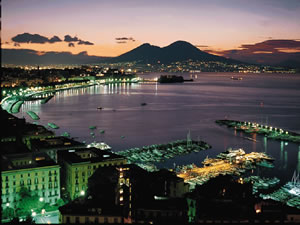
Naples is the third-largest city in Italy with a population of 800,000 inhabitants. During his visit, Goethe wrote that: “a man, who has seen Naples, can never be sad”. It is shaped in the form of semicircle, between the volcanic amphitheaters of the Flegrean fields and Vesuvius. The life and vitality of Neapolitan people give Naples the feel of a “real city” – Italy’s version of New York. Naples has a little bit of everything: the old centre, once the heart of the Neapolis of Antiquity and now jammed with ancient churches, a medieval university and countless restaurants and cafés, pulsates to the life of noisy street markets and their clientele, swarms of people darting about on mopeds, and the general chaos of a city at work.
Soon after founding Cumae in 1000 b.C., colonists from Rhodes established a settlement on the west side of Mt Vesuvius and, according to legend, named it after the siren Parthenope. It was later known as Palepolis, “the old city”. Later, during the V century b.C. Neapolis “the new town” was founded by Greek settlers coming from Eubea. In the IV century b.C. the city fell under Rome and became an ally of the powerful neighbouring city. Anyway Naples kept its Greek culture and due to the attractions offered by its countryside and climate Roman nobility settled there and built splendid villas. The spread of Christianity brought persecutions to Naples. The most famous victim was Saint Gennaro (Januarius), bishop of Benevento, who suffered martyrdom at Pozzuoli (IV century b.C.). After that he was made patron saint of the city. The breaking up of the Roman Empire brought the conquest by the Goths (V century) who were followed by the Byzantines. During the VIII century Naples became a self-governing duchy and managed to preserve its indipendence. With the Norman conquest under Roger d’Altavilla (1139) the downward trend of Naples’ predominance started and the capital city of the kingdom became Palermo. After the constitution of the “Free Commune”, there was the Swabian decline and the arrival of the Angevins. The Angevin period brought about an urban revival and marked a new development in the cultural life. Under the Aragonese rule the city took part in the dispute between the Spanish and the French, but the subsequent Spanish rule was one of the most troublesome periods in the history of Naples, marked by frequent uprisings by the population (that of Masaniello in 1647 is famous) and tormented by epidemic of the plague. Later conquered by the Austrians and delivered to Charles of Bourbon, Naples regained its former splendour as capital of an autonomous kingdom (1734). In 1860 Garibaldi invaded and joined it to Piedmont.
Naples streches along the waterfront and is divided into quartieri (quarters) – most street signs bear the name of the quarter as well.
The main train station , Stazione Centrale, and bus station are off Piazza Garibaldi, just east of Spaccanapoli, the old city.
A wide shopping street, Corso Umberto I, skirts the southern edge of Spaccanapoli, the ancient heart of Naples, on its way
south-west from Piazza Garibaldi to Piazza Bovio and on the huge Piazza Municipio, which is dominated by the Castel Nuovo.
From the waterfront directly behind the castle you can find boats to the bay islands, Palermo and other long-distance destinations.
The Royal Palace, the former royal palace, is next to the castle. From the palace, head north for Naples’ main street, Via Toledo,
wich becomes Via Roma for a short stretch after it crosses Piazza Carità, and you will reach Piazza Dante, on the western boundary
of Spaccanapoli. The road continues as Via Santa Teresa degli Scalzi and then Parco di Capodimonte north of the centre.
The extensions of two of Naples’more original streets, via Benedetto Croce (which becomes Via San Biagio dei Librai) and Via dei
Tribunali, eventually meet Via Roma. Most street life and many of the city’s artisans can be found in this area. Via San Biagio dei
Librai is part of an almost straight run from near the Stazione Centrale through Spaccanapoli to the foot of the hilltop Vomero district.
On the bay to the south-west are the more fashionable area of Santa Lucia and Mergellina, with its semi-grand waterfront boulevard,
Via Caracciolo (from where more boats head for the islands). Rising up from Mergellina is the up-market Vomero district, dominated
by the Castel Sant’Elmo and the Certosa of San Martino, a Cartusian monastery which can be seen from all over the city.